Himachal Reels Under Cloudburst Fury: Flash Flood Havoc Hits Kullu, Shimla & Lahaul-Spiti (Flash Floods in Himachal)
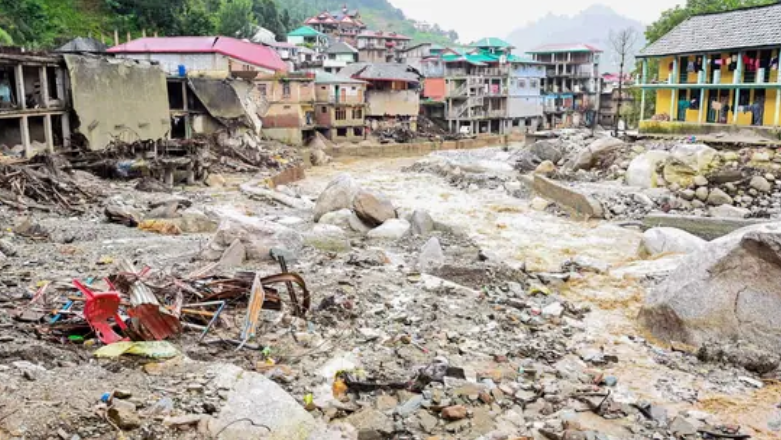
Breaking: Key Facts (As of 14 August 2025)
- Cloudbursts triggered devastating flash floods across Kullu, Shimla, and Lahaul-Spiti.
- 4 civilians stranded, 1 injured in Kinnaur due to a flash flood caused by a cloudburst.
- Over 323 roads blocked, multiple bridges washed away, and schools shut down across affected districts.
- In Shimla’s Rampur sub-division (Nanti village), two bridges, shops, and a police outpost were destroyed by torrential rains.
- The Kalka-Shimla Highway was shut down.
- In Kullu, two cloudburst points—Shrikhand (Bheemdwari, Kurpan rivulet) and Tirthan Valley (above Batahar village)—caused widespread damage: submerged villages, washed-away vehicles, cottages destroyed, and evacuation of Bagipul Bazaar.
- In Lahaul-Spiti (Mayad valley), flash floods wiped out bridges at Karpat, Changut, and Udgos Nala, damaging farmland and homes, prompting evacuations.
- The Indian Army conducted a daring night rescue in Kinnaur’s Hojis Lungpa Nala (Rishi Dogri Valley). Using LDHA drones, they delivered supplies and evacuated 4 stranded individuals and the injured to safety.(Flash Floods in Himachal)
Nature’s Furious Reminder
Himachal Pradesh was caught off-guard on 14 August 2025, as sudden cloudbursts unleashed flash floods that wreaked havoc across Kullu, Shimla, and Lahaul-Spiti. The onslaught was swift and merciless—villages submerged, bridges swept away, and roads rendered impassable within hours. To top it, four civilians were left stranded in the perilous terrain of Kinnaur, and one person was injured amid the chaos. Authorities are scrambling to restore connectivity, rescue affected residents, and tally the infrastructural damage.
1. Kullu District: Dual Cloudburst Strikes
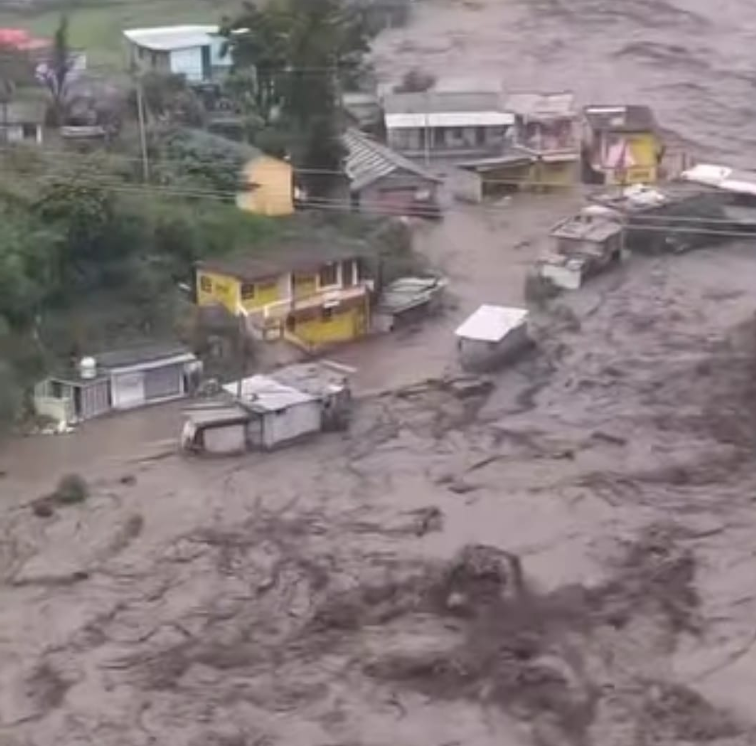
- Bheemdwari (Shrikhand Mahadev region): A sudden cloudburst above this high-altitude zone sent torrents through the Kurpan rivulet, submerging villages and forcing the evacuation of Bagipul Bazaar. Floodwaters carried debris and swept away vehicles along the path.
- Tirthan Valley (above Batahar village): Within hours, another cloudburst triggered a deluge that washed away three vehicles, destroyed four cottages, and inundated agricultural fields adjacent to the Tirthan River. Precautionary evacuation saved many lives.
- Impact on Infrastructure: Roads were flooded and collapsed; power supply systems were disrupted; and local markets, particularly in Bagipul, remained inaccessible as water levels surged.
2. Shimla District: Structural Damage & Isolation
- In Rampur subdivision, near Nanti village, a violent cloudburst obliterated two bridges, destroyed shops, and swept away a critical police outpost in the Ganvi ravine. The adjacent bus stand and several shops were also damaged.
- Connectivity Crisis: The Kalka-Shimla Highway, a key route, was immediately shut, isolating several rural communities and delaying rescue and relief preparedness.
3. Lahaul-Spiti District: Mayad Valley Disaster

- Flash floods in Karpat, Changut, and Udgos Nala obliterated bridges, severing access between remote hamlets. Crops were submerged, and several homes stood unsafe as water levels rose.
- Evacuations & Alerts: MLA Anuradha Rana confirmed evacuations and ordered school closures in the Miyar Valley as schools closed and rescue teams arrived.
4. Kinnaur: Night-time Army Rescue Mission
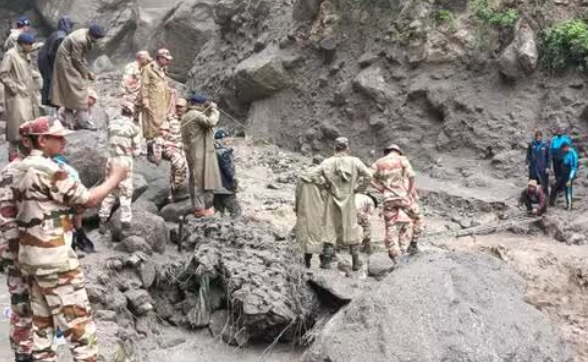
- In the Rishi Dogri Valley, a cloudburst resulted in a violent flash flood across Hojis Lungpa Nala, near a CPWD construction zone, damaging the Sutlej River bridge and leaving four civilians stranded with one injured.
- The Indian Army’s HADR contingent launched a bold rescue under dark, unstable conditions. Armed with LDHA drone support, they airdropped essentials and guided stranded civilians to safety. The injured was evacuated to Reckong Peo regional hospital, and the others were stabilized at an Army camp in Pooh.
5. State-wide Impact & Response Measures
- Road Closures: Over 323 roads statewide were blocked, including two national highways: NH-305 (Kullu) and NH-505 (Lahaul-Spiti).
- Infrastructure Damage: Bridges in multiple districts collapsed; schools were shut; communities were isolated; and water and power supplies remain disrupted in several towns.
- Emergency Alerts: The India Meteorological Department (IMD) issued orange alerts for Chamba, Kangra, and Mandi on August 14, with yellow alerts in other areas for the days ahead.
- Ongoing Relief Efforts: State Emergency Operations Centers and response teams are at work assessing damage, reopening key routes, and restoring essential services. Communities remain on high alert as monsoon conditions persist.
Massive Disruption in Himachal as Flash Floods Block 323 Roads and Hit Basic Services
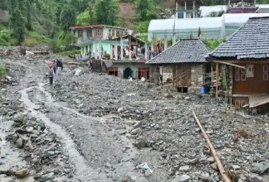
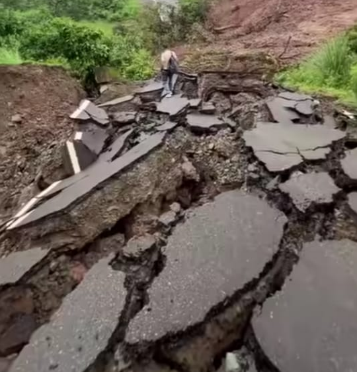
Himachal Pradesh continues to reel under the impact of recent flash floods and cloudbursts, with 323 roads blocked across the state as of Wednesday. The worst-affected district is Mandi, where 179 roads remain shut, severely hampering connectivity. Other affected districts include Kullu (70 roads), Kangra (25), Chamba (13), Sirmaur (11), Shimla (9), and Una & Lahaul-Spiti (7 each).
The damage is not limited to transportation. According to the State Emergency Operations Centre, essential services have also been hit hard — 130 water supply schemes are non-functional, leaving several villages without drinking water. Additionally, 79 electricity transformers are disrupted, leading to power outages in multiple areas.
These combined impacts highlight the scale of the crisis, with both urban and rural regions struggling to recover from the heavy rains. Relief and repair work is ongoing, but restoration is expected to take time due to the scale of destruction and continuing adverse weather conditions.
Orange Alert
Today, the India Meteorological Department (IMD) has issued an orange alert for several districts of Himachal Pradesh, including Kullu, Mandi, Shimla, Solan, Sirmaur, Bilaspur, and Hamirpur.
This alert warns of heavy to very heavy rainfall, which may lead to landslides, flash floods, and road blockages in vulnerable areas. Residents and tourists have been advised to stay indoors, avoid travel to hilly and landslide-prone regions, and follow safety advisories issued by the state authorities.
Monsoon’s Increasing Mayhem
These back-to-back cloudburst events underscore the growing volatility of monsoon patterns in the Himalayas. Rapidly swelling rivers, collapsed infrastructure, and mass evacuations are becoming alarmingly frequent. The Indian Army’s swift rescue in Kinnaur serves as a beacon of preparedness—but it also highlights the urgency of strengthening early warning systems, infrastructure resilience, and disaster preparedness across vulnerable hill regions. Climate change is not coming—it is already here, in the form of ferocious, erratic tragedies. Himachal’s resilience will be tested again—this monsoon season and beyond.

Pingback: Hurricane Erin’s Explosive Growth: Among the Fastest Intensifying Storms Ever Recorded - mineVerse360